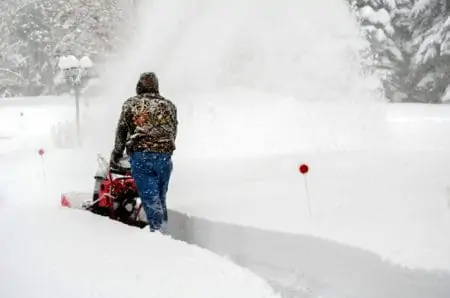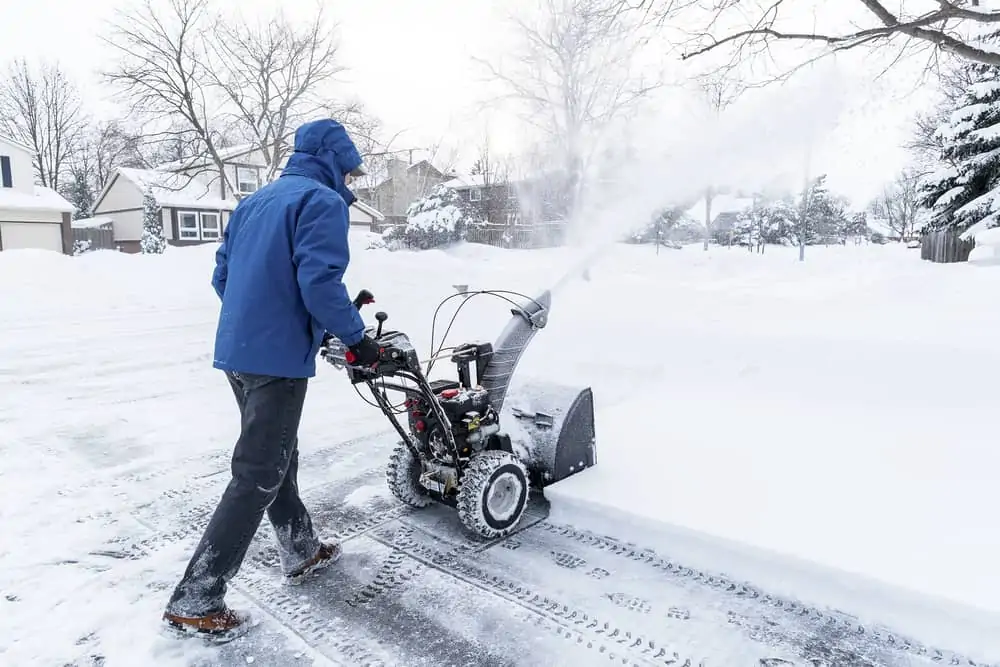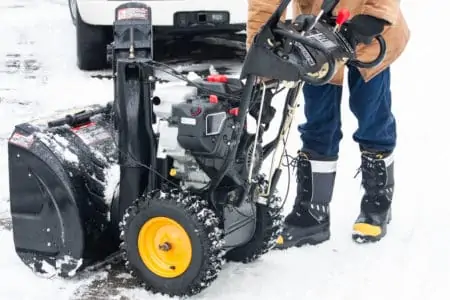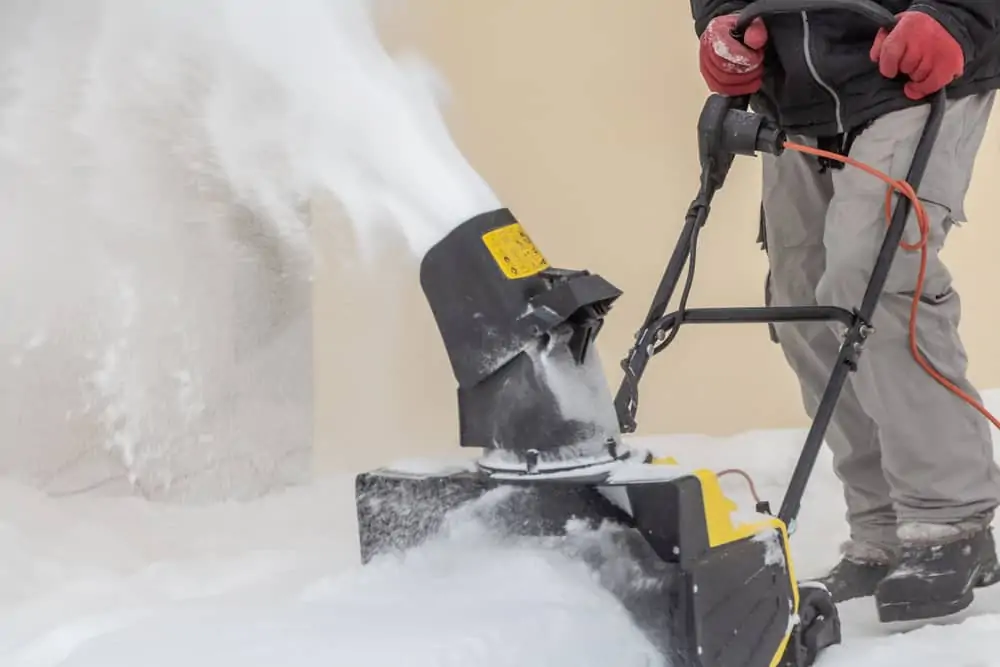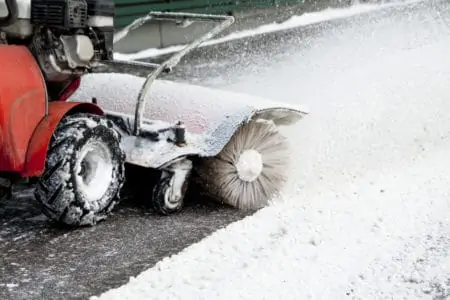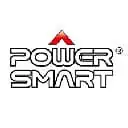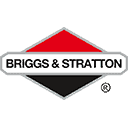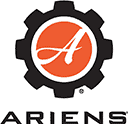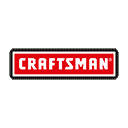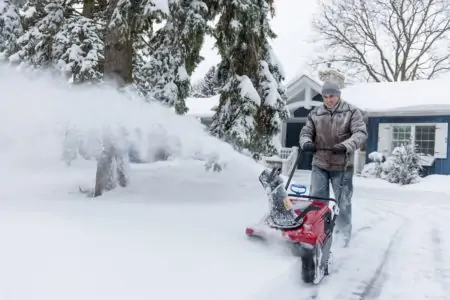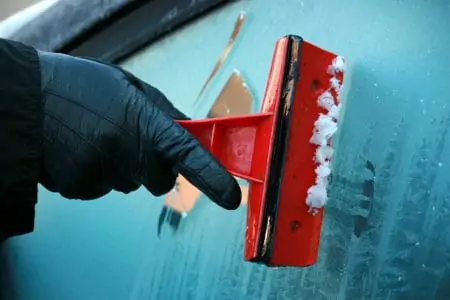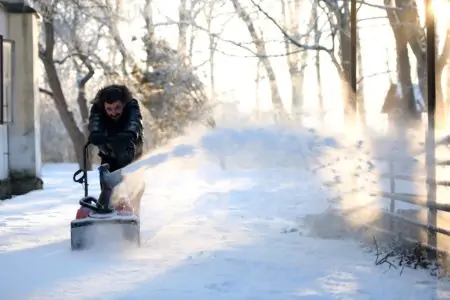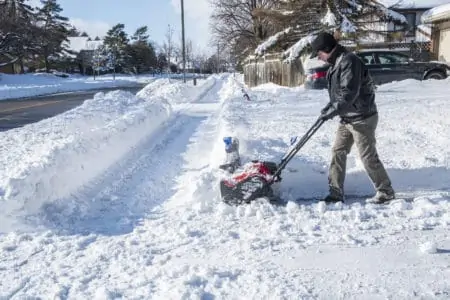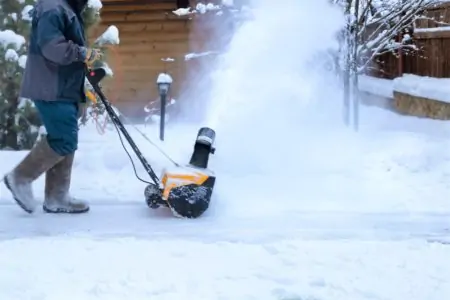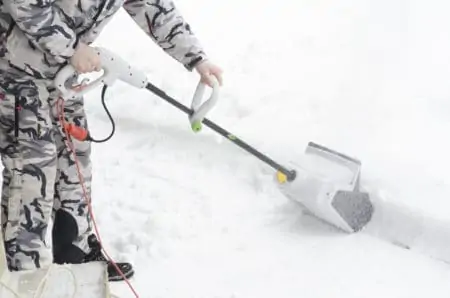Clearing snow from your yard is a real chore. You have two choices: using a snow shovel or buying a snow blower. Unless you fancy breaking your back shifting all that snow, a snow blower is your best option.
However, there are many factors to consider when it comes to choosing snow blowers. We explain the different models and what snow blower features to look out for.
Key Takeaways
- Choose the right type of snow blower: Single-stage for light snowfall and small areas, two-stage for moderate to heavy snowfall and larger areas, and three-stage for heavy snowfall and even larger areas.
- Consider the power source: Electric snow blowers are lighter, quieter, and require less maintenance, while gas-powered models offer more power and longer runtimes.
- Look for helpful features: Electric start, airless tires, headlights, and power steering can make snow blowing easier and more efficient.
- Take note of the brand’s reputation: Some popular snow blower brands include PowerSmart, Briggs and Stratton, Husqvarna, Snow Joe, Greenworks, and Craftsman.
Is a Snow Blower Worth It?
If you live in an area that gets snowfall every winter, a snow blower is handy. A shovel might work if you have a short driveway or a smaller plot of land. However, manual labor is not an option for some.
A snow blower takes the strain out of clearing snow; it moves a lot of the white stuff in one session and covers more ground. Plus, you can deal with deeper drifts.
If you live in an area that gets the odd snowstorm, a snow blower isn’t good value for money. But, if you get three or more severe snow falls a year, a snow blower will pay for itself time and again.
Types of Snow Blower
Choosing a snow blower can be challenging when you consider the variations between the different models. Is a single-stage better than a two-stage snow blower, and why are they different?
Single-Stage Snow Blower
This model has a one-speed auger (the blade that scoops the snow) that collects the snow from the ground and pushes it out of a chute. It can handle maximum snow depths of six inches on an average two-car driveway. It also shifts snow up to 18 inches wide in a single sweep.
The auger scrapes the ground, propelling the snow blower, but it is not the same as a self-propelled snow blower. Self-propelled blowers have forward and reverse gears that drive the wheels.
Two-Stage Snow Blower
A two-stage snow blower uses (you guessed it) a two-stage operation. The auger scoops the snow and throws it into an impeller (a fast-spinning fan) that pushes the snow out of the chute.
The advantage of the two-stage process is it can clear snowdrifts up to 12 to 16 inches over larger areas. Two-stage snow blowers are typically self-propelled with multiple forward speeds, so that they can clear snow on slight inclines.
They also have larger augers and more powerful engines; plus, a maximum clearance width of 24 inches.
Three-Stage Snow Blower
A three-stage snow blower has two augers. The first spins more slowly to scoop more significant amounts of snow. The second auger (known as an accelerator) moves faster, tossing the snow rapidly towards the impeller and then out of the chute.
This extra power means that a three-stage model removes snow 50 percent faster than a similar two-stage machine. You get a clearance depth of 18 inches or more, and you can cover an area many times the size a two-stage snow blower can cover.
Three-stage snow blowers also have a wider clearance path. Typically, they can clear a strip of snow up to 28 inches.
Take Note
All snow blowers have a drive belt that wears out over time, but two and three-stage models have several belts, so you will need to know how to replace them when it happens.
Here’s a handy guide to help you see the difference between the models:
| Features | Single-Stage | Two-Stage | Three-Stage |
| Ease of Use | Easy | Moderate | Hard |
| Snow Depth | 6 to 9 inches | 12 to 16 inches | 18+ inches |
| Snow Width | 18 inches | 24 inches | 28 inches |
| Best Uses | Light to moderate snow. Small plots and two-car driveways. | Moderate to heavy snow. Three-car driveways and medium-sized plots. | Heavy snowfall. Four-car driveways and large plots of land. |
| Price | $$$ | $$$$ | $$$$$ |
Electric Vs. Gas Vs. Self-Propelled Snow Blowers
With such a variety of snow blowers on the market, deciding which one is best for your property is tricky. Gas-powered snow blowers are tried-and-trusted machines that have been around for generations, but electric models are fast catching up.
Electric
Electric snow blowers come in corded and cordless varieties. Corded snow blowers are great for small areas because they are the ultimate easy-to-use machines. You don’t need to worry about oil changes or the other stresses that come with gas-powered models.
This Greenworks Corded snow blower is an excellent example of a compact model best suited to lighter duties like small driveways and paths.
However, watch that the power cord doesn’t get chopped by the auger. You’ll also need a heavy-duty extension cable and are limited to where you can go because you always need a power socket nearby.
Cordless models give you all the freedom of gas-powered models, so you can cover larger areas, but they don’t give you the same power levels. Battery-powered snow blowers have a finite runtime because the battery will only hold a charge for a specific time.
A single charge should last about 30 minutes, although if you want to keep going for longer, buy a second battery.
This means you are restricted to lighter snow because the battery lacks the staying power of gas models. However, like the corded varieties, they require minimal maintenance, making them the best option if you are not practically minded.
Electric snow blowers are also considerably cheaper to buy, which is part of the reason why they are growing in popularity. Not everyone has heavy snowfall or large plots, so electric models are an alternative option.
Pros
- Cheaper to buy.
- Minimal maintenance.
- Easy to use.
- Lighter and easier to store away.
- Plugin and go.
Cons
- Only suitable for lighter snow.
- Lacks power.
- Needs a power socket.
- Battery has a finite life.
- Suitable for smaller areas.
Gas
Gas-powered snow blowers have been around for generations, but how do they compare to the new kids on the block? This PowerSmart Two-Stage Blower is a great example of a workhorse that will clear snow to a depth of 10 inches. It also has a clearance path of 24 inches.
They are also the best option for clearing compacted and frozen snow, thanks to the increased power of the auger.
Gas-powered models are the most robust because they keep going no matter what the conditions. They are the best choice for clearing wider areas, and they don’t have the same battery life and cord length restrictions.
Gas-powered machines require higher maintenance, including oil changes and drive belt replacement; plus, there is the ongoing cost of the fuel. Electric snow blowers cost you nothing other than the purchase price.
But when it comes to capacity and snow clearance, gas-powered models are impossible to beat. Whether you opt for a single, two, or three-stage snow blower, they beat the electric varieties hands down.
That said, they are also expensive, with some of the top models costing thousands, so unless you need all that power, go electric. Even some basic models will set you back several hundred dollars.
Plus, gas-powered snow blowers are heavier than electric models, so maneuvering them around your yard could put additional strain on your arms and back. You can buy models with power steering, but that ramps up the costs further.
Pros
- Work in all weather conditions.
- Greater depth and clearance capacity.
- Longer runtime between refueling.
- Go-anywhere machines.
- Better for larger plots.
- Clears frozen and compacted snow.
Cons
- Heavy and tricky to maneuver.
- Require greater maintenance.
- Ongoing gas costs.
- Expensive compared to other varieties.
Self-Propelled
Essentially, self-propelled snow blowers are gas varieties because self-propulsion helps you to maneuver heavier machines. You can get electric models, but it is less common.
Typically, self-propelled snow blowers have between four and six forward speeds, so you can find a comfortable forward momentum. They have a couple of reverse gears as well.
A self-propelled snow blower will also make light work of the most frozen and compacted snow. This PowerSmart model is an excellent example of a self-propelled snow blower with a clearance width of 24 inches and a snow depth of 12 inches.
The engine works on a similar principle as a car motor, with a drivetrain that moves the wheels forward when in gear. Given that standard snow blowers weigh between 150 and 200 pounds, it makes them easier to control.
If you get deep snow, you should choose a self-propelled machine because the forward motion helps them chew through the deepest drifts. If you have a large plot of land, a self-propelled model will also put less strain on your back and arms.
Be prepared to dig deep if you want a self-propelled snow blower. You would only choose one if you had a plot large enough that you would get your money’s worth. They also tend to be the larger machines, which makes them a challenge to store away.
Pros
- Forward and reverse gears.
- Better for larger plots of land.
- Ideal for deep snow.
- Chews through compacted and frozen snow.
Cons
- More expensive than other models.
- Heavy machines.
- Hard to store away.
What to Look for In a Snow Blower
Snow blowers vary enormously between models and manufacturers. Your budget will dictate the features and benefits, but what other things should you keep in mind?
Is it only the blowers clearance capacity and power source, or are there other factors to focus on when making your decision?
Number of Stages
From single, two, and three-stage machines, how your blower performs depends on how it clears the snow. As discussed, one-stage models are perfect for snow about six to nine inches deep. They are about the same size as a small push-along lawn mower and ideal for level driveways.
A single-stage snow blower would suit a concrete or asphalt driveway but would struggle on dirt or slopes. Because single-stage machines use the auger to gain traction, you can’t use them on gravel or dirt.
Two-stage machines are bigger and bulkier than single-stage snow blowers, which makes them heavier. The two-stage process clears more snow at a faster rate, making them better for larger areas.
These blowers can clear snow to a depth of 12 to 16 inches, making them perfect for residential use. They are also useful if you have a gravel path because the auger skims the ground but doesn’t make contact.
Three-stage snow blowers are for severe snowfalls to a depth of 18 inches or more, and some larger models can clear depths up to 24 inches. When you step up to a three-stage machine, you clear snow faster, making the task that much easier.
That said, you will pay for the privilege; plus, three-stage snow blowers are harder to store away given their size.
Power Source
If you don’t like gas-guzzling snow blowers, go electric. There are some excellent models on the market that perform almost as well as the gas varieties. You have a choice between corded and cordless, with each having advantages and disadvantages.
If you go corded, you need a power socket and a heavy-duty extension cable. You are restricted on where you can go and risk chopping through the cord.
Cordless models give you the same freedom as gas-powered snow blowers but without fumes and pollution. You probably need a spare battery so you can charge it while using the other.
This keeps you working non-stop between charges. You only get about 30 minutes of runtime, which is no match for the gas-powered machines.
Wheels or Tracks
Most snow blowers have wheels rather than tracks. Single-stage snow blowers are easier to push because they are lighter, so they don’t need tracks. However, for two and three-stage models, tracks are a useful thing because they increase traction.
Also, if you have uneven ground with slopes and hills, a snow blower with tracks helps you negotiate the ground with ease.
Bear In Mind
Tracks are harder to maneuver and turn on flat ground.
How Much Snowfall?
The amount of snow you get determines the type of snow blower you should buy. Single-stage blowers suit light snowfall, while two and three-stage machines prefer heavy snowfall.
And because most two and three-stage snow blowers have traction with multiple forward and reverse gears, compacted and frozen snow doesn’t stand a chance.
Weight and Size
Most snow blowers are heavy machines; even single-stage models can weigh between 80 and 100 pounds. You can expect two-stage models to weigh between 200 and 250 pounds. And three-stage machines are even heavier, at 250 plus pounds.
The weight and size of your snow blower matter, especially if you struggle to maneuver it due to age or limited mobility. Keep this in mind because the last thing you want is a machine that you cannot operate. Electric models are much lighter, at around 30 to 50 pounds.
Snow Blower Additional Features
So far, we’ve covered the essentials of snow blowers, but what about the additional features that make clearing snow easier? A lot depends on your budget because the more you spend, the more features you can get.
Electric Start
An electric start takes all the muscle strain out of firing up your snow blower on cold mornings. No more pulling a ripcord; just flick a switch, and the motor fires into life. It also reduces the chances of flooding the motor if it doesn’t start the first time.
You would need to pull the cord at least 20 times to clear a flooded petrol engine. Electric start motors plug into an AC power socket and start the engine with a push of the button.
Airless Tires
Airless tires make the snow blower easier to control and keep it moving in a straight line. Inflated tires always need topping up with air, and if one is flatter than the other, the blower pulls to one side.
Airless tires are made from a special polymer material that gives them as much traction as pneumatic tires, but they never run flat and always grip. They are also maintenance-free, making them a great choice.
Headlights
Winter days can be overcast, so having headlights increases your visibility. It also makes you more visible to pets and family members. Plus, if the snow starts falling in the early morning, you can get to work straight away without waiting for the sunrise.
They also let you see obstacles clearly, which avoids accidents and damage to your snow blower.
Look for a Plastic Chute
Plastic chutes are better because they don’t rust, and they are formulated to be slippier. It means they are less likely to get blocked with snow, and throw the white stuff further. Plastic is also flexible, so it doesn’t crack in the cold.
Metal snow chutes can dent, crack, and rust, which means the snow sticks to the walls, causing blockages.
Auto-Chute Rotation
Manual chute rotation requires you to pull a lever to get it to change direction. You need to do this at the end of every pass when you turn and make your way in the opposite direction. Auto-chute rotation removes the need to think about it.
Every time you change direction, the chute switches sides via an electronic switch on the control panel. It even adjusts the chute trajectory automatically to get the maximum throwing distance. This saves you time and effort because it removes the need for manual adjustments.
Power Steering
Power steering is more common on higher-quality two and three-stage snow blowers. It helps you to maneuver them and keep control. Some newer models even have one-handed power steering so you can turn the machine on a pinhead.
Power steering is one of the most useful features on a snow blower, especially on heavier models. Imagine trying to drive your car without power steering, and you’ll get some idea how cumbersome a snow blower can be.
Best Snow Blower Brands
There are so many brands of snow blowers that the choice can seem endless, but which are the brands that stand out? Do they offer better value for money and reliability? Let’s find out.
FAQs
The Final Say
If you are sick and tired of shoveling snow every time you get a dump of the white stuff, buying a snow blower is the ideal convenience tool. It saves your back and arms from aches and strains, and it gets the job done faster.
Whether it’s a gas-powered model or an electric snow blower, shifting the snow from your driveway keeps you moving.
